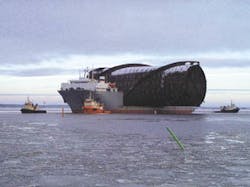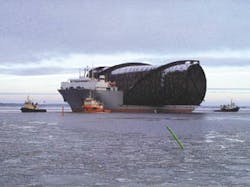US Gulf's Diana and King next for spar floater production line
Latest concept acquires open truss base as Amoco dispenses with storage
Vicky Wilson
Contributing Editor
The 10,000-ton lower section of the Genesis spar hull and mooring system leaving Finland for Corpus Christi.
- Each half of the Genesis spar was assembled on rails located at the quayside prior to loading which was accomplished by using a hydraulic pushing system to slide the completed structure onto the heavy lift vessel. [57,494 bytes]
- Aker Raumas' new truss spar concept utilizes cylindrical sections in the upper part of the hull, while the bottom section is made up of an open truss structure. [33,079 bytes]
Aker Rauma is devoting 100% of its capacity at its Mantyluoto yard near Pori in Finland to building spars, representing 40% of its overall turnover. The remaining 60% has been transferred to the firm's Caspian Sea operations where it concentrates on offshore construction work and modifications to drilling structures.
Aker Rauma's method of working has also changed considerably over the last few years, according to sales manager Jarmo Eerola. "In the past, we used to do sequential work whereby the oil companies commissioned the engineering for a project with a separate company and then contracted yards such as ourselves to carry out the fabrication." Now, with its own design engineering arm, PI Rauma which is also based in Pori, Aker Rauma is able to offer concurrent engineering design and fabrication.
"There are always some risks involved" says Eerola, "but they are controllable and can be shared with our clients. Ultimately the benefits, such as much shorter lead times, far outweigh any risks."
The company's first spar project was for the Oryx Neptune Field, a 215-meter-long, 22-meter-diameter hull capable of operating at water depths approaching 600 meters. The spar hull was completed in September 1996, with first oil achieved in March 1997.
Following on from that initial success, Aker Rauma has just completed the Genesis spar hull for the Chevron Green Canyon Field and is busy working on two further spars, one of which is for Exxon's Diana Field.
Genesis spar
The overall dimensions of the Genesis spar are much larger than the earlier Neptune project since the structure has been designed to operate in deeper water of up to 800 meters. With a hull diameter of over 37 meters, the individual spar sections were too large to construct as complete units inside the company's fabrication sheds.As a result, each section was made in two parts and then joined together using a unique heavy lift push-up system developed by Swedish company Rigging Management Systems.
Working on a jacking principle, the push-up system uses two masts with the load placed on a lock plate above the jacks which are raised one meter at a time.
After each lift, the load is locked off, the jacks retracted, a piston inserted to maintain the load and the jacks repositioned to lift the load another meter. For the Genesis project, the smaller top sections, each weighing up to 850 tons were raised 25 meters for mating with the bottom sections in an operation that took around 4 1/2 hours. A total of 21 single lifts took place over a 17-month period to complete the two halves of the hull.
Construction details
Constructing the spar in 42 separate pieces meant that each section had to be built to extremely small tolerances. "Each section must be absolutely round" says Eerola, "therefore each plate cannot deviate by more than 3 mm. The technique requires good measurement tools and bending the steel in jigs to exactly the right shape."By using normal offshore grade steel, there is no requirement for pre-heating which makes welding a simple operation. Each section takes three months to complete from the time the steel plate is cut so new sections are started every three weeks to fit into an on-going assembly line schedule.
Each half of the Genesis spar was finally assembled on rails located at the quayside incorporating a hydraulic pushing system to slide the completed structure onto the heavy lift vessel. The bottom half of the hull weighed about 10,000 tons when shipped in December of last year to Aker Gulf Marine in Corpus Christi, using the Transhelf barge.
Transportation
The Transhelf returned to Pori in February to transport the heavier 17,000-ton top section, representing the biggest spar heavy lift operation to date. On its arrival at Corpus Christi, the two halves will be joined together while they are floating in the water by welding the top part and then rotating the hull to weld the bottom section.The completed spar is due to be towed out to the Green Canyon Field in May and upended around two weeks later by filling the bottom section with water. The operation will take around 70 seconds. The installation will be carried out by J Ray McDermott.
The Genesis hull will be kept on station using 14 mooring lines and, to prevent vibration caused by the sea currents, strakes have been fitted curving down the entire length of the hull. The hull form itself also results in a very limited heave movement.
Aker Rauma believes that the spar concept is very competitive compared with traditional TLP structures.
"An important aspect for oil companies is that the risers come up through the central well of the hull, which allows the dry wellheads to be situated on the platform rather than the seabed," says Eerola. "This makes the overall project much cheaper and the construction schedule is also very competitive."
Other spars
Even before the Genesis spar left the Mantyluoto works, Aker Rauma had started on the construction of the another 37.2-meter diameter spar hull for Exxon's Diana Fieldin the US Gulf of Mexico. With field approval due in March, construction commenced in November under a pre-commitment contract valid until this month.
Also bound for the US Gulf of Mexico, the hull is due to leave Finland in October next year. Engineering on a third Genesis-sized spar is also underway for another Gulf of Mexico field, which is due to be completed in August 2000.
Although spar hulls are constructed to the same basic design, the final outfitting varies for each project depending on a variety of factors such as the operating water depth, which can alter the number of tank spaces required at the top end of the hull structure, leading to different configurations of pumps and piping. The riser layout also determines the size and number of supports in the central well.
Meanwhile, Aker Rauma is carrying out front-end engineering work on a smaller 90-ft diameter spar for the Amoco King Field, also destined for the Gulf of Mexico. The company anticipates getting the go-ahead this summer for its new spar hull and mooring system referred to as a truss spar.
Truss spar concept
This new concept utilizes cylindrical sections as in existing designs in the upper part of the hull, while the bottom section is made up of an open truss structure similar to the leg of a jackup rig.Heave plates are used to dampen the vertical heave motions and the truss structure is not so vulnerable to currents.
"We knew in advance that there would be no requirement for oil storage which meant that there was no need to build a fully cylindrical structure for the entire length of the spar" comments Eerola. "The result is a much lighter hull which is faster and therefore cheaper to build.
We tried to have this concept accepted for the Marlin project but at the time Amoco decided to go for a TLP. After the Neptune spar was successfully completed, however, the spar concept has become more established. We understand that Amoco is firmly committed to the idea of the truss spar."
In addition to ongoing developing of spar hulls, Aker Rauma is developing new design concepts for operations in Arctic regions.
The company has developed two units, the RR-3190 for year-round exploration drilling in shallow Arctic waters, and a similar unit, the RR-3090, designed for drilling and production in similar conditions.
Copyright 1998 Oil & Gas Journal. All Rights Reserved.

